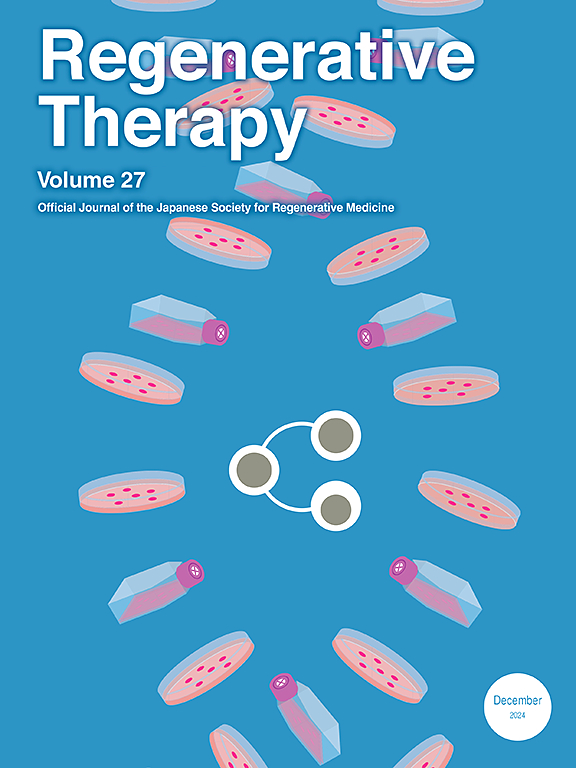Hydrogel in musculoskeletal diseases: Unraveling trends, research foci, and future trajectories via bibliometric insights (from 2000 to 2025)
IF 3.5
3区 环境科学与生态学
Q3 CELL & TISSUE ENGINEERING
引用次数: 0
Abstract
Introduction
Hydrogels, owing to their excellent biocompatibility, tunable physicochemical properties, and ability to mimic the extracellular matrix, have emerged as promising materials for the treatment of musculoskeletal disorders, including osteoarthritis, intervertebral disc degeneration, and bone injuries. Recent advancements in smart hydrogels and multifunctional composites have further broadened their applications in drug delivery, tissue engineering, and regenerative medicine. However, despite growing interest in this field, current reviews often lack systematic, data-driven insights into the evolving research landscape.
Methods
To address this gap, we conducted a bibliometric analysis using CiteSpace and VOSviewer to quantitatively map the development of hydrogel-related research in musculoskeletal disorders over the past two decades. Key parameters analyzed included publication trends, influential countries and institutions, collaborative networks, keyword evolution, and research hotspots.
Results
Our analysis revealed a steady growth in publications, with China and the United States emerging as leading contributors. Prominent institutions and authors were identified, along with landmark publications that have shaped the field. Keyword co-occurrence analysis highlighted emerging themes such as injectable hydrogels, 3D bioprinting, and osteochondral regeneration. The most frequently studied disease targets included osteoarthritis, intervertebral disc degeneration, and bone defect repair.
Conclusions
This comprehensive bibliometric overview offers valuable insights into the current status and future directions of hydrogel research in musculoskeletal disorders. It highlights key trends, influential contributors, and emerging hotspots, providing a solid foundation for advancing interdisciplinary collaborations and accelerating the clinical translation of hydrogel-based therapies.
水凝胶在肌肉骨骼疾病中的应用:通过文献计量学分析揭示趋势、研究重点和未来发展轨迹(从2000年到2025年)
水凝胶由于其优异的生物相容性、可调节的物理化学性质和模拟细胞外基质的能力,已成为治疗肌肉骨骼疾病(包括骨关节炎、椎间盘退变和骨损伤)的有前途的材料。智能水凝胶和多功能复合材料的最新进展进一步拓宽了它们在药物输送、组织工程和再生医学方面的应用。然而,尽管人们对这一领域的兴趣日益浓厚,但目前的综述往往缺乏对不断发展的研究前景的系统的、数据驱动的见解。为了弥补这一空白,我们使用CiteSpace和VOSviewer进行了文献计量分析,定量绘制了过去20年水凝胶相关研究在肌肉骨骼疾病中的发展。分析的关键参数包括出版趋势、有影响力的国家和机构、合作网络、关键词演变和研究热点。结果:我们的分析显示,论文发表量稳步增长,中国和美国成为主要贡献者。突出的机构和作者,以及具有里程碑意义的出版物,塑造了该领域。关键词共现分析突出了可注射水凝胶、3D生物打印和骨软骨再生等新兴主题。最常研究的疾病目标包括骨关节炎、椎间盘退变和骨缺损修复。这一全面的文献计量学综述为水凝胶在肌肉骨骼疾病中的研究现状和未来方向提供了有价值的见解。它突出了关键趋势、有影响力的贡献者和新兴热点,为推进跨学科合作和加速水凝胶疗法的临床转化提供了坚实的基础。
本文章由计算机程序翻译,如有差异,请以英文原文为准。
求助全文
约1分钟内获得全文
求助全文
来源期刊

Regenerative Therapy
Engineering-Biomedical Engineering
CiteScore
6.00
自引率
2.30%
发文量
106
审稿时长
49 days
期刊介绍:
Regenerative Therapy is the official peer-reviewed online journal of the Japanese Society for Regenerative Medicine.
Regenerative Therapy is a multidisciplinary journal that publishes original articles and reviews of basic research, clinical translation, industrial development, and regulatory issues focusing on stem cell biology, tissue engineering, and regenerative medicine.
 求助内容:
求助内容: 应助结果提醒方式:
应助结果提醒方式:


